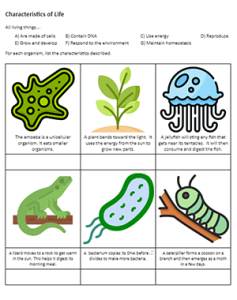
Most biology textbooks begin with the scientific method and characteristics of life. You would think that life characteristics would be simple and straightforward. Even young children can discern between something that is alive, like a cat 🐈 and something that is not alive, like a rock 🪨.
One of my favorite early demonstrations is “Sewer Lice.” The set-up is simple, you tell students a story about a mysterious discovery in the sewer. Show them a beaker with raisins in carbonated water. The raisins will float to the top and then sink, mimicking the behavior of a life form that is surfacing for air.
This is a good way to introduce the concept of life characteristics. How do we know when something is alive? Most biology texts will list 5-8 criteria. The current textbook I use (Miller and Levine, Bee book) lists eight.
- Made up of cells
- Reproduce
- Contain a genetic code (DNA)
- Growth and development
- Energy Use
- Response to environment
- Homeostasis
- Evolution
Applying Knowledge
After students learn the characteristics, I like to give them a chance to apply their knowledge. In this worksheet, students are given a set of scenarios that describe one or more traits of a living thing. Students match the description to one or more of the listed life characteristics.
On the second page, students read a set of observations and match them to characteristics of life. The observations apply to two objects: fire and a snail. Obviously, fire is not alive, but the snail is. Though it seems simple, the exercise is about matching the observed traits to the list. Fire can be tricky. It displays some aspects of living things, such as reproduction and using energy. Though most students know that fire is not technically “alive.”
You can find the entire class curriculum and resources at the Biology 1 and 1A page.

